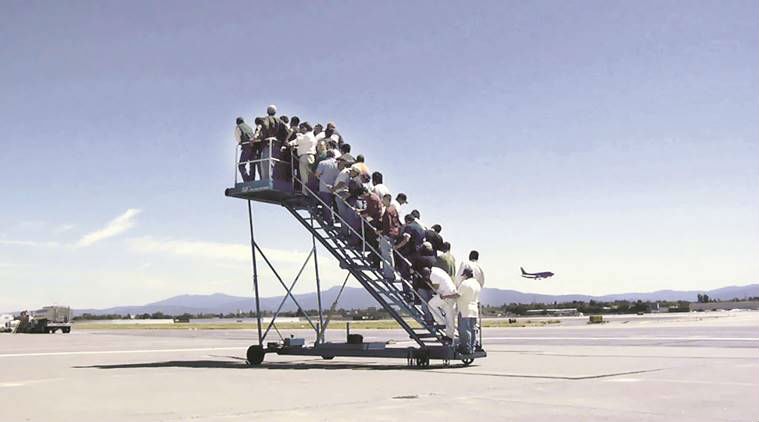War and Peace
An exhibition in Delhi, which explores the ongoing social and political conflicts around the world, tells a story about the struggle and pain that renders man-made borders inconsequential.
 Milan-based Adrian Paci’s work exhibits a video of a group of people standing on the airport ladder, waiting for a plane that never arrives.
Milan-based Adrian Paci’s work exhibits a video of a group of people standing on the airport ladder, waiting for a plane that never arrives.
On the second floor of India International Centre (IIC), Delhi, the art gallery — dark, cold and sparse — is unyielding to the warm afternoon sun outside. Inside, one sees a large video work, featuring a woman seated on layers and layers of bottari (bundle in Korean) atop a moving truck. The vehicle, it seems, is en route winding roads in a countryside. The context, at first instance, is missing, but the visual is clear in its intent — migration — something that coincides with the physical atmosphere that is cold, and has a brittle sense of isolation. The work, titled Cities on the Move: 2727 kilometres Bottari Truck, Korea comes from Korean artist Kimsooja, who toys with the usage of the word bottari, also a cultural connotation for a woman leaving her family to pursue her own life. In a way, the artist’s journey in her work becomes a departure point to “Getting Across”, an exhibition of works by 22 artists, Indian and international, that takes off from questions pertaining to the ongoing political, social and cultural struggle that has erupted from the recent wars and the consequent influx of refugees.
The works, mostly in the form of photographs and videos, with a few on paper and canvas, are spread across three venues — the IIC, Bikaner House and Vadehra Art Gallery. “Leonhard and I started working on the project about a year ago when one topic overshadowed all the other political issues in Europe: the influx of refugees seeking shelter from the murderous civil war, as well as from social and political injustice, and oppression executed in the name of religion. Questions needed to be raised,” says Kanika Kuthiala, Programme Coordinator, who curated the show with Leonhard Emmerling, Director Programmes, South Asia. Kimsooja’s work leads us further to a distilled visual narrative that reiterates that borders are man-made; the struggle gruesome and experienced by all. Artists from across the world have captured this struggle and conflict. In that effort, their voices become one.
After Kimsooja, there’s German photographer Andre Lutzen and his collage of 17 photographs taken in different parts of the world — from the distant boundary river with Syria in south Turkey in the night to empty corners of the houses and rooms in Russia and Spitsbergen, and a more immediate visual of immigrants arriving in Canary Islands in Spain in 2006. Munich-based Eva Leitolf comes with “Postcards from Europe”, an ongoing archive since 2016, wherein detailed landscapes meet the absence of humanity. Swiss artist Roman Signer’s Don’t Cross the Line, a video work, is his “recording experiment”, wherein a hand-held camera takes the viewers on a journey along a “Don’t Cross the Line” yellow tape, jumping over and ducking under on occasions.

Step out and into Delhi’s Bikaner House, and the window to conflicted zones opens up further. It begins with Australian artist Mike Parr and his visceral performance in Close the Concentration Camps (2002), in which he, in solidarity with refugees in Australia’s detention centres, had his lips sewn with surgical thread. Further inside are works that draw boundaries and partition, such as Zarina Hashmi’s A Map without a City (1971) and Abyss (2013). These are stark, black-and-white works in his trademark minimalistic drawings. Then there is Berlin-based Jens Ullrich’s series Refugees in a State Apartment (2015-ongoing), in which he positions refugees at the central reception center in Berlin-Moabit to create an atmosphere that hangs between intimacy and rootlessness. A separate segment in this venue, deep within its corridors, hosts a series of frames, all white and explained with texts. “Address not found”, says one, while another is one of blurred names in Hindi by artist Shilpa Gupta with the post script, “100 fake names to enroll children into school in the neighbourhood”.
“There are commonalities inherent within varied political scenarios cutting across geographical boundaries. We need to examine whether we move towards a world that is increasingly globalised economically, but at the same time, compartmentalised ethnically, religiously and politically,” says Kuthiala, “Do we move towards a world of cosmopolitanism, or do we face a world of isolationism and nationalism? With this in mind, we wanted to have varied voices and made a selection of artists from across geographical regions who are, or have, dealt with the issue at hand,” he adds.
Vadehra Art Gallery explores the subject with sublimity. While Milan-based Adrian Paci’s work exhibits a video of a group of people standing on the airport ladder, waiting for a plane that never arrives, Mexico-based artist Francis Alÿs paints a road divider in his video work. Raqs Media Collective has put up Will You Beloved Stranger, an installation and video work that places the poetic rendition of Israeli poet Yehuda Amichai and Palestinian poet Mahmoud Darwish. Their verses merge together as artists Amit Gour and Ruba Amira Salameh read out scripts such as “Too many memorial days, too little remembering…too many dreamers, too few dreams”, or “I have nothing to say about the war, nothing to add. I’m ashamed. I always lose, even in victory” — the words that sum up the exhibition.



- 01
- 02
- 03
- 04
- 05























